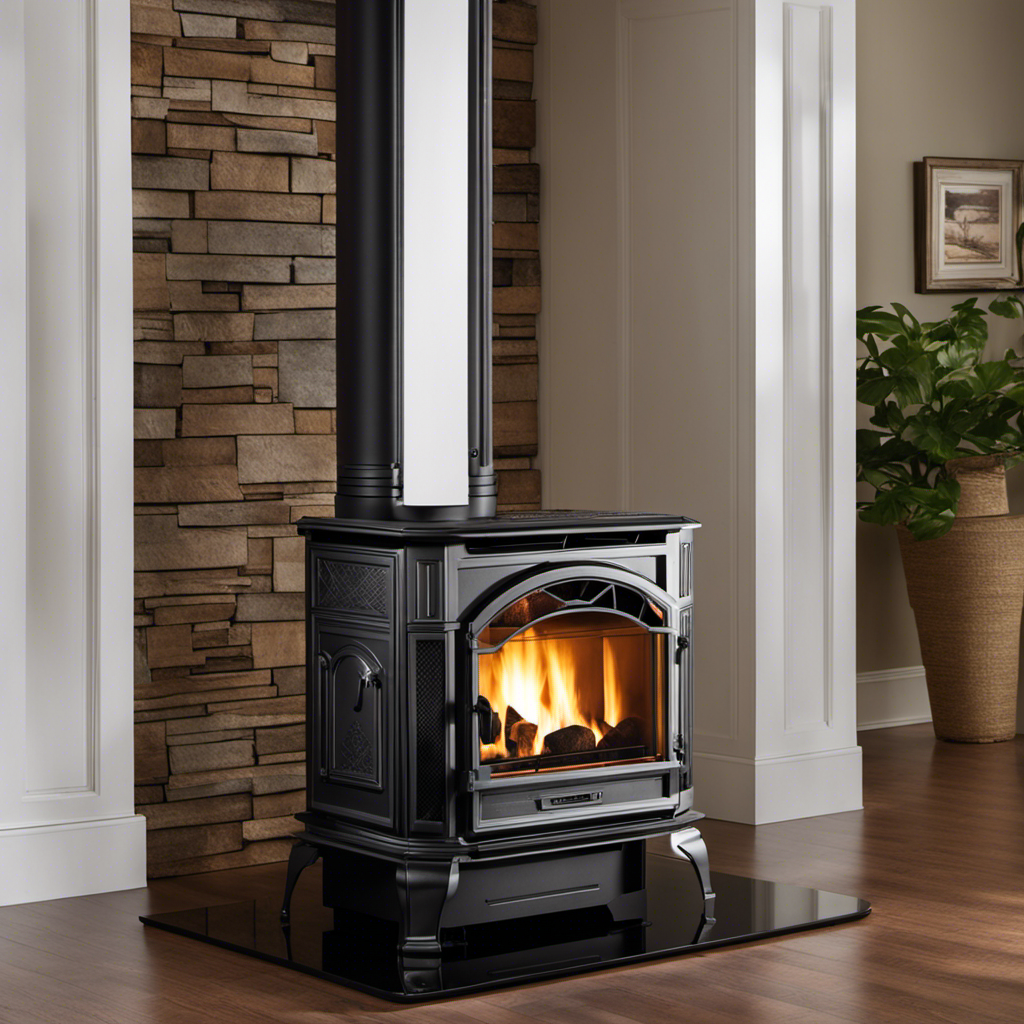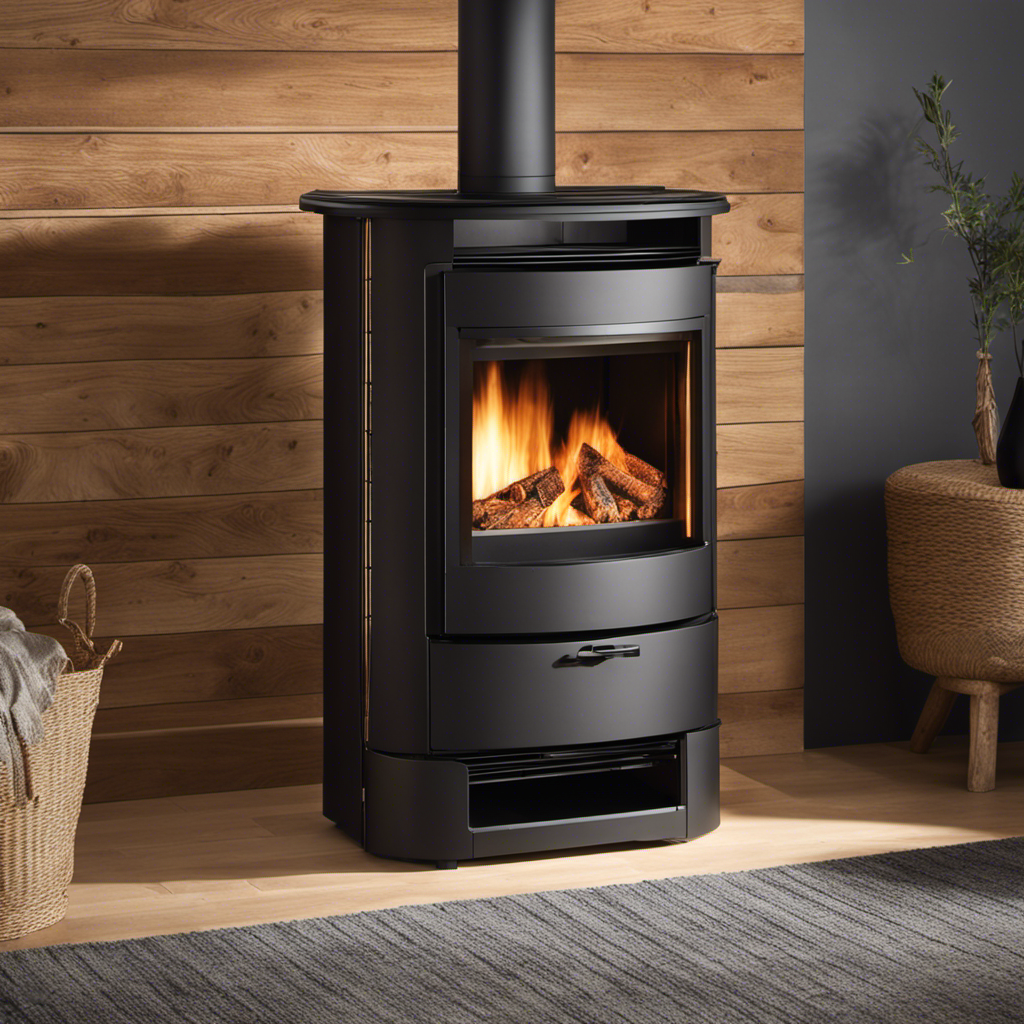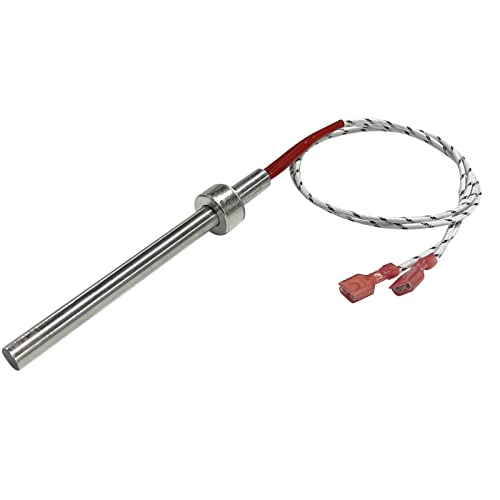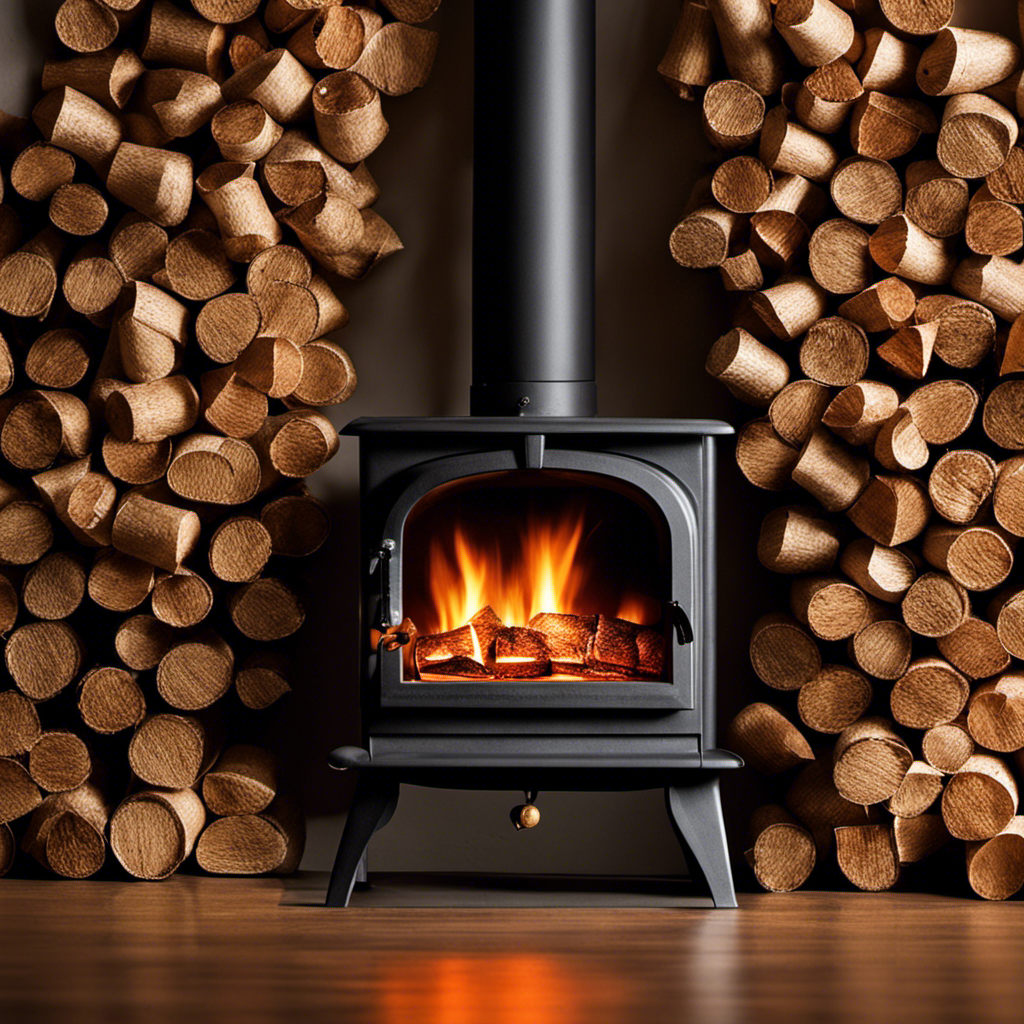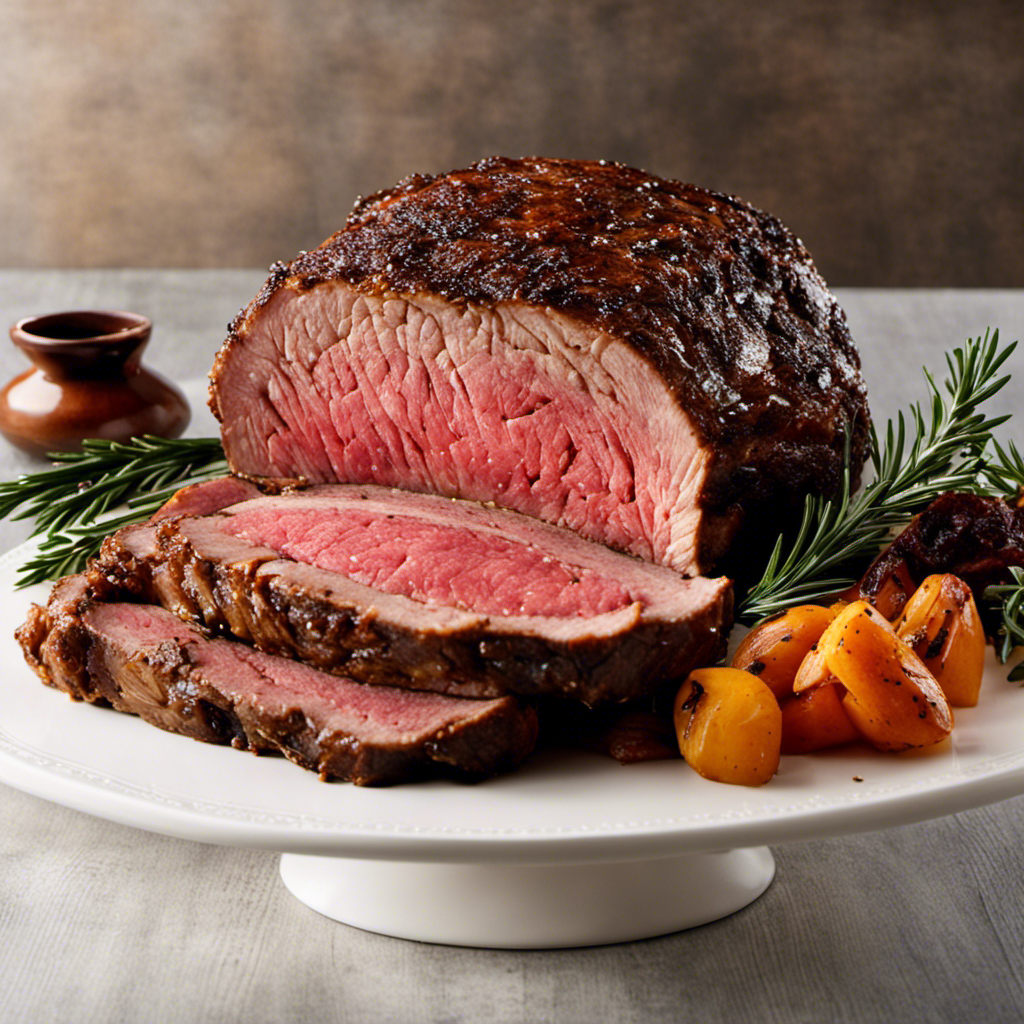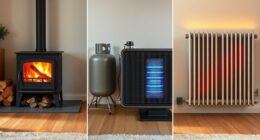Fed up with spending a lot on expensive heating expenses and systems that fail to deliver? Worry no more, you’ve come to the right place! Here, we offer solutions to improve the efficiency of your pellet stove.
Pellet stoves are not only affordable, but also environmentally friendly. In this article, we’ll dive into the factors that impact pellet stove performance, such as size, heat output, and efficiency rating.
We’ll also discuss how regular maintenance and proper installation can greatly enhance your stove’s efficiency. Get ready to save money and reduce your carbon footprint with these tips!
Key Takeaways
- Choosing the right size stove optimizes fuel efficiency
- Higher heat output potential heats space more effectively
- Efficiency rating reduces fuel consumption and environmental impact
- Regular maintenance maximizes efficiency and extends the lifespan of the stove
Factors to Consider When Choosing a Pellet Stove
When choosing a pellet stove, we should consider factors such as the make and model, size, heat output potential, efficiency rating, and age and condition of the stove.
Understanding fuel cost is crucial in determining the long-term affordability of a pellet stove. Pellet quality plays a significant role in the efficiency of the stove. Poor quality pellets can lead to reduced heat output and increased maintenance needs. High-quality pellets, on the other hand, burn more efficiently, producing more heat and less ash. This not only maximizes the stove’s efficiency but also reduces the frequency of cleaning and maintenance.
It’s important to choose a pellet stove that can burn a variety of pellet brands effectively, ensuring flexibility in fuel choices.
Understanding the Impact of Stove Size on Efficiency
We can improve the performance of our pellet stove by considering the size of the stove and its impact on efficiency.
The size of the stove has a direct influence on fuel consumption. A smaller stove may require less fuel to operate, while a larger stove may consume more fuel. By choosing the right size stove for our needs, we can optimize fuel efficiency and reduce costs.
Additionally, using environmentally friendly heating options, such as pellet stoves, offers various benefits. They’re a renewable energy source, produce fewer emissions than traditional heating methods, and help reduce our carbon footprint.
How the Heat Output Potential Affects Fuel Consumption
The heat output potential of our stove directly impacts our fuel consumption and efficiency. Understanding how the heat output potential affects fuel consumption is crucial for maximizing pellet stove efficiency.
Heat output potential refers to the amount of heat that a stove can produce. A stove with a higher heat output potential will generate more heat, allowing us to heat our space more effectively. This means that we can achieve our desired temperature faster and maintain it with less fuel consumption.
On the other hand, a stove with a lower heat output potential may require more fuel to achieve the same level of warmth. Therefore, when choosing a pellet stove, it’s important to consider its heat output potential to ensure optimal fuel efficiency.
The Role of Efficiency Rating in Maximizing Efficiency
Our goal is to find the most efficient pellet stove by considering its efficiency rating.
When it comes to maximizing efficiency, the age and condition of the stove plays a significant role in fuel consumption.
Additionally, the size of the stove also affects pellet consumption, as larger stoves tend to burn more pellets to produce the desired heat output.
By understanding the relationship between stove size and pellet consumption, we can make informed decisions when selecting a pellet stove.
It’s important to note that an efficient pellet stove not only reduces fuel consumption but also helps to minimize environmental impact.
Therefore, when choosing a pellet stove, it’s crucial to consider its efficiency rating and the potential impact of stove age on fuel consumption.
Importance of Stove Age and Condition for Fuel Efficiency
When considering fuel efficiency, the age and condition of the stove play a crucial role.
The importance of stove insulation can’t be overstated. Proper insulation helps to retain heat, allowing for more efficient combustion and reducing fuel consumption.
Regular stove maintenance is also essential in maximizing efficiency. By keeping the stove clean and well-maintained, you can ensure optimal performance and prevent any potential issues that may hinder fuel efficiency.
Regular maintenance includes cleaning the burn pot, checking and replacing gaskets if necessary, and inspecting the exhaust system for any blockages.
Additionally, regular maintenance helps to extend the lifespan of the stove and reduce the risk of costly repairs in the future.
Duration of a 40lb Bag of Pellets in Different Stove Models
In our experience, different stove models can vary in the duration of a 40lb bag of pellets. Factors such as burn rate comparison and the impact of stove size on burn time play a significant role in determining how long a bag of pellets will last.
-
Burn rate comparison: Some stoves have a higher burn rate, meaning they consume pellets at a faster rate than others. This can result in a shorter duration for a 40lb bag of pellets.
-
Impact of stove size: Larger stoves typically have a higher heat output potential, which can lead to a faster burn rate and a shorter duration for a bag of pellets.
-
Efficiency rating: Stoves with higher efficiency ratings can make better use of the pellets, resulting in a longer burn time for a bag.
-
Maintenance and cleaning: Regular upkeep of the stove ensures optimal performance and can contribute to longer burn times.
-
Temperature settings: Adjusting the temperature settings can help optimize burn time and maximize efficiency.
Factors Affecting Burn Rate and Variation in Pellet Consumption
Factors such as the make and model of the stove, its size, heat output potential, efficiency rating, and age and condition all contribute to the burn rate and variation in pellet consumption. These burn rate factors directly impact how quickly pellets are consumed and how long a bag will last in a pellet stove.
The make and model of the stove determine its overall efficiency and performance, while size and heat output potential affect the amount of heat generated and the rate at which pellets are burned.
Additionally, the age and condition of the stove can impact its efficiency and the way it consumes pellets. Understanding these factors can help homeowners make informed decisions about their pellet stove and optimize its performance to achieve maximum efficiency and minimize pellet consumption.
Essential Maintenance and Cleaning Tips for Efficiency
By regularly performing maintenance and cleaning tasks, we can ensure that our pellet stove operates efficiently and optimally. Here is a pellet stove maintenance checklist to help you troubleshoot common pellet stove issues:
- Clean the stove’s exhaust vent and combustion chamber to remove any build-up or debris that could hinder performance.
- Check and clean the stove’s air intake to ensure proper airflow and combustion.
- Inspect and clean the stove’s hopper, removing any pellets or dust that may have accumulated.
- Clean or replace the stove’s gaskets and seals to maintain a tight seal and prevent air leaks.
- Regularly inspect and clean the stove’s auger and motor to ensure smooth pellet delivery.
Following these maintenance tasks will help keep your pellet stove running smoothly and efficiently.
If you encounter any issues beyond regular maintenance, consult a professional technician for further troubleshooting and repairs.
Selecting a High-Efficiency Pellet Stove: What to Look For
When it comes to selecting a high-efficiency pellet stove, there are a few key factors to consider.
One of the most important considerations is the impact of stove size on fuel consumption. Larger stoves generally have a higher heat output potential, which can lead to increased fuel consumption.
However, it’s important to note that the efficiency rating of the stove also plays a significant role in fuel consumption variation. A stove with a higher efficiency rating will convert more of the pellets into usable heat, resulting in lower fuel consumption.
Therefore, when choosing a high-efficiency pellet stove, it’s crucial to find the right balance between stove size and efficiency rating. By doing so, you can maximize the heat output while minimizing fuel consumption, ultimately saving both energy and money.
Using the Right Size Pellets for Optimal Performance
We can achieve optimal performance from our pellet stove by ensuring we use the right size pellets. Choosing appropriate pellets is crucial as it directly impacts the performance of the stove. The quality of the pellets plays a significant role in how efficiently the stove burns and how long the fuel will last.
Here are some key points to consider when selecting pellets for your stove:
- Look for pellets that are made from high-quality wood with minimal additives.
- Opt for pellets that have a low moisture content, as this will result in better combustion and less ash buildup.
- Consider the diameter of the pellets, as some stoves may perform better with larger or smaller sizes.
- Check for certification labels, such as the Pellet Fuels Institute (PFI) label, which ensures the pellets meet certain quality standards.
- Read customer reviews and ratings to get an idea of the overall performance and satisfaction with a particular brand or type of pellets.
Ensuring Proper Installation and Ventilation for Efficiency
Proper installation and ventilation are essential for ensuring the efficiency of our pellet stove.
When it comes to maximizing the performance of our stove, proper maintenance and the importance of ventilation can’t be overstated.
Regular maintenance and cleaning are crucial for keeping the stove running smoothly and efficiently. This includes cleaning the stove’s components, such as the burn pot and the exhaust system, as well as inspecting and replacing any worn-out parts.
Additionally, ensuring proper ventilation is essential for the stove to operate efficiently. Good ventilation helps to remove the combustion gases produced by the stove, preventing the build-up of harmful pollutants and ensuring proper air circulation.
Optimizing Temperature Settings for Maximum Efficiency
To get the most out of our pellet stove, we should aim to optimize the temperature settings for maximum efficiency. By finding the right balance, we can maximize the burn rate while minimizing fuel consumption. Here are some key points to consider:
-
Adjusting the temperature: Increasing the temperature too high can lead to unnecessary fuel consumption, while setting it too low may result in insufficient heat output. Finding the optimal temperature range is crucial for efficient fuel usage.
-
Maintaining the burn rate: The burn rate refers to the amount of pellets burned per hour. By optimizing the temperature settings, we can maximize the burn rate and ensure that the stove is operating at its most efficient level.
-
Impact on fuel consumption: Temperature has a direct impact on fuel consumption. Higher temperatures generally result in increased fuel usage, while lower temperatures can help conserve fuel. Finding the right balance is essential for optimizing efficiency.
-
Monitoring and adjusting: Regularly monitoring the temperature and adjusting it as needed can help us maintain optimal fuel consumption and maximize the stove’s efficiency.
-
Consideration for weather conditions: External factors like weather conditions can also influence the temperature settings. Adjusting the settings according to the season and climate can further optimize fuel consumption.
Frequently Asked Questions
What Are Some Tips for Optimizing Temperature Settings to Maximize Pellet Stove Efficiency?
To maximize pellet stove efficiency, optimizing temperature settings is crucial. By finding the right balance, we can ensure efficient fuel consumption and optimal heat output.
Adjusting the temperature to the lowest comfortable setting helps reduce fuel usage while still maintaining a cozy environment. It’s also important to avoid constantly changing the temperature, as this can lead to wasted fuel.
How Does the Size of the Pellets Affect the Performance and Efficiency of a Pellet Stove?
The size of the pellets has a significant impact on pellet stove efficiency and performance. Smaller pellets tend to burn more efficiently and produce a higher heat output, as they have a larger surface area for combustion.
On the other hand, larger pellets may not burn as efficiently and can lead to more frequent maintenance and cleaning.
It is important to use the right size pellets recommended by the manufacturer to maximize pellet stove efficiency and ensure optimal performance.
What Are Some Essential Maintenance and Cleaning Tips to Improve the Efficiency of a Pellet Stove?
Maintenance tips and cleaning techniques are essential for improving the efficiency of a pellet stove. Regular maintenance actually saves time and money in the long run, despite potential objections that it is time-consuming. It includes cleaning the stove and chimney, inspecting and replacing gaskets, and checking and adjusting the combustion settings. These tasks ensure optimal performance, prevent clogging, and extend the lifespan of the stove.
Cleaning techniques should also focus on removing ash, dust, and debris from the stove and its components.
What Factors Should Be Considered When Selecting a High-Efficiency Pellet Stove?
Factors to consider when selecting a high-efficiency pellet stove include:
- The make and model, size, heat output potential, efficiency rating, and age and condition of the stove. These factors directly impact the stove’s ability to effectively burn pellets and maximize heat output.
By carefully considering these factors, we can choose a pellet stove that isn’t only efficient but also meets our heating needs.
Proper selection of a high-efficiency pellet stove is essential in maximizing its performance and ensuring optimal fuel consumption.
How Does Proper Installation and Ventilation Contribute to the Overall Efficiency of a Pellet Stove?
Proper installation and ventilation are crucial for maximizing pellet stove efficiency. By ensuring a correct installation, we can prevent heat loss and maintain optimal airflow. This contributes to better fuel combustion and heat distribution throughout the home, reducing energy waste.
Adequate ventilation removes any combustion byproducts, promoting a cleaner and safer environment. To improve pellet stove efficiency through installation and ventilation, it’s essential to hire a professional, follow manufacturer guidelines, and regularly clean and maintain the stove and chimney.
Conclusion
In the quest for efficient and cost-effective heating, the secrets to maximizing pellet stove efficiency have been uncovered.
By understanding the factors that impact performance, such as stove size, heat output potential, and efficiency rating, and by implementing regular maintenance and proper installation, you can unlock the full potential of your pellet stove.
With the right temperature settings, pellet size, and ventilation, your stove will operate at its peak, saving you money and reducing your carbon footprint.
Embrace these secrets and let your pellet stove shine.

